Release 8.1.5
A67774-01
Library |
Product |
Contents |
Index |
| Oracle8i Migration Release 8.1.5 A67774-01 |
|
This chapter covers the steps that must be completed before you migrate a production database. This chapter covers in detail Steps 1 through 3 of the migration process, which were outlined in Chapter 1.
This chapter covers the following topics:
The information in this chapter is generic and applies generally to Oracle7 and version 6 production databases.
|
See Also:
Oracle8i Replication, Appendix B, "Migration and Compatibility", if you are migrating a database system that has Advanced Replication installed. |
Complete the following tasks to prepare to migrate:
Before you plan the migration process, become familiar with the new features of the Oracle8i database. Getting to Know Oracle8i is a good starting point for learning the differences between release 8.1, release 8.0, and release 7.3. Also, check specific books in the Oracle documentation library to find information about new features for a certain component; for example, see Oracle8i Parallel Server Concepts and Administration for changes in Oracle Parallel Server.
Choose one of the following methods to migrate your database to Oracle8i:
The Migration utility is a command-line utility for migration of a complete database from Oracle7 to Oracle8i. It changes datafile headers but leaves actual data unchanged. It does not copy data.
The Oracle Data Migration Assistant has a graphical user interface (GUI) for migration or upgrade of a complete database. It changes datafile headers but leaves actual data unchanged. It does not copy data.
Export/Import can migrate parts of the database. Export/Import leaves datafile headers and actual data unchanged, and makes a new copy of the data.
Data copying can migrate parts of the database. Data copying leaves datafile headers and actual data unchanged, and makes a new copy of the data.
Table 2-1 summarizes the advantages of each of these methods. Table 2-2 summarizes the disadvantages of each of these methods.
The following sections describe each of the migration methods in detail, covering the relative amounts of time and space the methods require and the situations in which the methods are most appropriate.
The Migration utility is a command-line utility that converts files and structures in the Oracle7 source database to Oracle8i format, changing only the file headers and, if necessary, the definitions of the data in the files. The Migration utility does not change the data portions of the datafiles, nor their format or content.
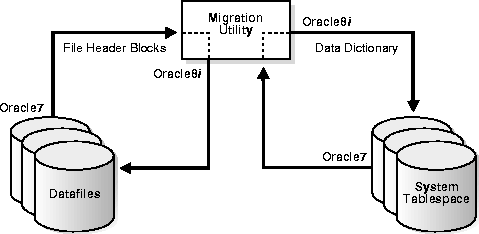
The primary advantages of using the Migration utility are speed and relative ease of use. The Migration utility takes significantly less time than Export/Import, and its use entails a standardized series of specific, easy steps. In addition, the time required to migrate a database with the Migration utility depends less on the size of the database than on the number of objects in the data dictionary.
The Migration utility is especially useful for quickly migrating an entire source database. Unlike Export/Import, the Migration utility cannot selectively migrate specific datafiles. However, for databases with large amounts of data, large datatypes, and some other Oracle7 features, Export/Import may not be feasible, and the only practical options may be either the Migration utility or the Oracle Data Migration Assistant.
The Migration utility requires only enough temporary space in the SYSTEM tablespace to hold both the Oracle7 (source) and Oracle8i (target) data dictionaries simultaneously.
The Migration utility converts the entire database, including database files, rollback segments, and the control file(s). At any point before actually migrating the Oracle7 database, you can open and access data with the Oracle7 instance. However, after the Migration utility has migrated the Oracle7 source database to Oracle8i, you can go back to Oracle7 only by restoring a full backup of the Oracle7 source database.
The Migration utility cannot perform direct migrations on release 7.0 databases, nor on databases below a specific 7.1 release. The specific 7.1 release requirement is operating-system specific. For example, on some operating systems, the Migration utility can migrate only release 7.1.4 and higher databases to Oracle8i. If you are using a release below the release supported by the Migration utility on your operating system, you first must migrate or upgrade your database to a supported Oracle7 release before using the Migration utility to migrate to Oracle8i. See your operating-system specific Oracle documentation for information about the earliest release supported by the Migration utility on your operating system.
|
See Also:
Chapter 3, "Migrating Using the Migration Utility", for detailed information about using the Migration utility. |
The Oracle Data Migration Assistant provides a user-friendly, graphical user interface (GUI) that guides you through the migration process. The Oracle Data Migration Assistant calls the Migration utility and runs it in the background, which means that you avoid running the Migration utility manually from a command-line.
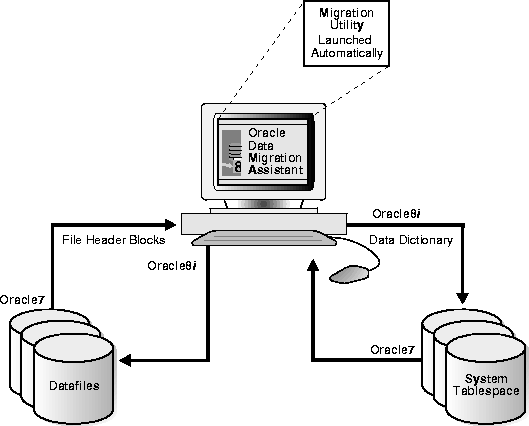
The primary advantage of the Oracle Data Migration Assistant is that it is easy to use. Because the Oracle Data Migration Assistant calls the Migration utility, most of the advantages and disadvantages of the Migration utility also apply to the Oracle Data Migration Assistant. The section "Choosing Between the Oracle Data Migration Assistant and the Migration Utility" provides information about the differences between the Oracle Data Migration Assistant and the Migration utility.
|
See Also:
Chapter 4, "Migrating Using the Oracle Data Migration Assistant", for detailed information about using the Oracle Data Migration Assistant. |
When choosing between the Oracle Data Migration Assistant and the Migration utility, consider these differences:
initsid.ora file. See "Initialization Parameters Obsolete in Version 8" for lists of the obsolete parameters that are removed by the Oracle Data Migration Assistant. In contrast, the Migration utility does not alter your initsid.ora file, and you should remove the obsolete parameters manually if you use the Migration utility.
In general, if you prefer a graphical user interface (GUI) over a command-line interface, and you like highly automated processes with few choices, use the Oracle Data Migration Assistant. If, on the other hand, you prefer a command-line interface over a GUI, and you like to have more control over the migration process, use the Migration utility.
Unlike the Migration utility, the Export/Import operation physically copies data in the source database to a new database. The source database's Export utility copies specified parts of the source database into an export file. Then, the Oracle8i Import utility loads the exported data into the new Oracle8i database. However, the new Oracle8i target database already must exist before the export file can be migrated into it.
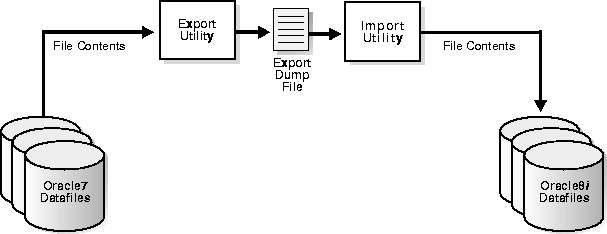
The following sections highlight aspects of Export/Import that may help you to decide whether to use Export/Import for migrating your database.
|
See Also:
Chapter 5, "Migrating Using Export/Import", and also Oracle8i Utilities, for more information about using Export/Import for migration. |
The Export/Import method of migration does not change the source database, which enables the source database to remain available throughout the migration process. However, if a consistent snapshot of the database is required (for data integrity or other purposes), the source database must run in restricted mode or must otherwise be protected from changes during the export procedure. Because the source database can remain available, you can, for example, keep an existing Oracle7 production database running while the new Oracle8i database is being built at the same time by Export/Import. During this migration, to maintain complete database consistency, changes to the data in the Oracle7 database cannot be permitted without the same changes to the data in the Oracle8i database.
The Export/Import method also can be used to upgrade or downgrade a database. For example, the transformation of an Oracle8i database back into an Oracle7 database can be accomplished using Export/Import.
Most importantly, the Export/Import operation results in a completely new database. Although the source database ultimately contains a copy of the specified data, the migrated database may perform differently from the original source database. As a result of data defragmentation, database restructuring by the DBA, and the new Oracle8i software, expect changes in the following areas:
Careful planning, expert implementation, and rigorous testing are required to take advantage of the possible positive effects of Export/Import on the database; otherwise, the database changes may create problems. If the database was restructured during migration, and the migrated database behaves differently, it may be difficult to determine the cause(s) of the differences.
Data migration by Export/Import offers the following benefits:
Data migration by Export/Import has the following limitations:
Migrating an entire database by using Export/Import can take a long time, especially compared to using the Migration utility or the Oracle Data Migration Assistant. Therefore, you may need to schedule the migration during non-peak hours or make provisions for propagating to the new target database any changes that are made to the source database during the migration.
The time and system resources (particularly disk space) required for Export/Import migration depend on DBA skill, database size, and the type of data to be migrated, particularly the number, size, and type of indexes that must be rebuilt.
For example, a relatively simple 6-gigabyte, Oracle7 database was migrated to Oracle8i using the Migration utility in about an hour. The same Oracle7 database was exported, producing a single 2-gigabyte export dump file. To import that one export dump file took 20 hours. The complete migration using the steps described in "Migrate the Pre-Release 8.0 Source Database Using Export/Import" took two days.
Consider the following factors related to the extended time required to migrate a database by Export/Import:
When importing data from an earlier version, the Oracle8i Import utility makes appropriate changes to data definitions as it reads earlier versions' export dump files. That is, it handles dump files produced by the Export utilities of Oracle version 6, version 7, and version 8. If the export source database is earlier than version 6, the source database must first be upgraded to at least version 6 before the export is performed.
You can copy data from one Oracle database to another Oracle database using database links. For example, you can copy data from a source database table to a target database table with the SQL*Plus COPY statement, or you can create new tables in a target database and fill the tables with data from the source database by using the INSERT INTO command and the CREATE TABLE ... AS statement.
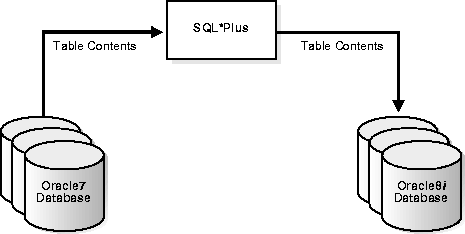
Copying data and Export/Import offer the same advantages for migration. Using either method, you can defragment data files and restructure the database by creating new tablespaces or modifying existing tables or tablespaces. In addition, you can migrate only specified database objects or users.
Copying data, however, unlike Export/Import, enables the selection of specific rows of tables to be placed into the target database. Copying data is thus a good method for migrating only part of a database table. In contrast, using the Export/Import to migrate data from Oracle7 to Oracle8i, you can migrate only entire tables.
For example, to create a new table (NEW_EMP) that contains a subset of the data in an existing table (EMP@V7DB, only the employees in departments 10 and 20), you can use the following SQL statement:
CREATE TABLE new_emp AS SELECT empno, ename, job, mgr, hiredate, sal, comm, deptno FROM emp@v7db WHERE deptno IN (10, 20);
Copying data requires less disk space and memory buffer space for migration than Export/Import because copying data requires only that the source database and the target database both are online. There is no need to allocate large amounts of extra space for temporary files or for export dump files.
The SQL*Plus COPY command is useful for working with large clustered tables. Further, the SQL*Plus COPY command can move portions of the cluster in parallel using Net8 (or SQL*Net). For more information about copying data from one database to another, refer to the CREATE TABLE command in the Oracle8i SQL Reference and to the COPY command in the SQL*Plus User's Guide and Reference.
Estimate the system resources required for successful migration. Different migration methods may result in different resource requirements; therefore, if you are not certain of the method you want to use, complete an estimate for each potential method of migrating the existing database to Oracle8i.
Consider the following factors in your estimates:
Oracle8i binaries may require as much as three times the disk space required by Oracle7 binaries. This threefold increase can require special attention on large batch systems (which may generate dozens or hundreds of executables). The space required for executables also depends on the options you choose for the Oracle8i environment, such as the following:
In addition, the Oracle8i data dictionary may require as much as double the space of the Oracle7 data dictionary in the SYSTEM tablespace. If you plan to use the Migration utility, you can estimate space requirements for the SYSTEM tablespace by running the Migration utility in CHECK_ONLY mode.
Also, Oracle8i may require up to twice as much RAM as Oracle7. The amount of RAM required also depends on the options you choose for the Oracle8i environment.
Figure 2-5 illustrates the differences in system requirements between Oracle7 and Oracle8i.
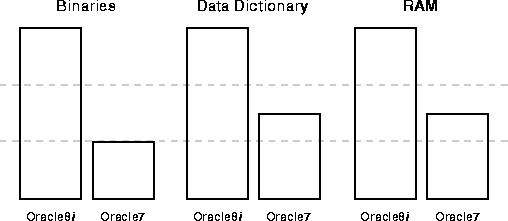
After you have chosen a migration method and estimated your requirements, secure the necessary resources for a successful migration.
The memory size of a Oracle8i system depends on concurrent access and the way in which concurrent access is accomplished. Oracle8i supports the following connect options:
|
Option 1: |
Use local connections in dedicated server architecture (also called "two-task common"). Set this option as it was set in Oracle7. |
|
Option 2: |
Use remote connections through SQL*Net. Set this option as it was set in Oracle7. |
|
Option 3: |
Use multithreaded shared servers for local and remote connections. After migrating, set initialization parameters for this option as specified in the Oracle8i Administrator's Guide. |
|
Option 4: |
Use transaction processor (TP) monitors. |
Option 1 requires more memory than Option 2 or Option 3. With Option 1, if both client application and its Oracle server (or shadow) process reside on the same computer, memory is required for both. For example, 100 client application processes connected to Oracle8i results in 100 additional Oracle server processes on the system, totaling 200 in all.
With Option 2, only the Oracle processes reside on the system, and the client processes are connected remotely. Thus, you need to consider only to the size of the Oracle server processes and the size of the available shared memory.
Option 3, using multithreaded server architecture, enables the processes of several local or remote client processes to connect to a single dispatcher process, instead of having a dedicated Oracle shadow process. While not designed as a performance enhancement, multithreaded server configuration enables more concurrent connections on an Oracle8i server, thereby improving throughput. Multiple clients can connect to a single dispatcher, so the memory utilization for concurrent user connections decreases. For further information on the multithreaded server feature of Oracle8i, see Oracle8i Concepts and the Oracle8i Administrator's Guide.
Option 4, use of TP monitors, is an alternative for systems requiring a high number of users (greater than several hundred) all performing OLQP/OLTP type transactions. Such transactions are usually short-lived and do not require the user to make a direct connection to the database. All transactions are performed with messages routed by the TP (transaction processor) monitor service. The TP layer provides named services and coordinates service requests with various DBMS systems, including Oracle.
In summary, you can estimate system memory requirements, for a single system, by considering the following factors:
You must choose an Oracle home directory for the new Oracle8i release that is separate from the Oracle7 Oracle home directory. You cannot install the Oracle8i software into the same Oracle home directory that you used for Oracle7.
Using separate installation directories enables you to keep your Oracle7 software installed along with the Oracle8i software. This method enables you to test the migration process on an Oracle7 test database before replacing your production environment entirely.
You can save time by eliminating common migration problems before you migrate your database. Common problem areas include the following:
The ultimate success of your migration depends heavily on the design and execution of an appropriate backup strategy. To develop a backup strategy, consider the following questions:
Your backup strategy should answer all of these questions and include procedures for successfully backing up and recovering your database.
|
See Also:
The Oracle7 Server Administrator's Guide for Oracle7 databases and the Oracle8i Backup and Recovery Guide for Oracle8i databases. |
You need a series of carefully designed tests to validate all stages of the migration process. Executed rigorously and completed successfully, these tests ensure that the process of migrating the production database is well understood, predictable, and successful. Perform as much testing as possible before migrating the production database. Do not underestimate the importance of a test program.
The testing plan must include the following types of tests:
Migration testing entails planning and testing the migration path from the source database to the migrated database, whether you use the Migration utility, the Oracle Data Migration Assistant, Export/Import, or other data-copying methods to migrate the production database data to the target database. These methods are discussed in Chapter 3, "Migrating Using the Migration Utility", Chapter 4, "Migrating Using the Oracle Data Migration Assistant", and Chapter 5, "Migrating Using Export/Import".
Regardless of the migration method you choose, you must establish, test, and validate a migration plan.
Minimal testing entails moving all or part of an application on the source database to the target database and running the application without enabling any new target database features. Minimal testing is a very limited type of testing that may not reveal potential issues that may appear in a "real-world" production environment. However, minimal testing will reveal any application startup or invocation problems immediately.
Functional testing is a set of tests in which new and existing functionality of the system are tested after migration. Functional testing includes all components of the RDBMS system, networking, and application components. The objective of functional testing is to verify that each component of the system functions as it did before migrating and to verify that new functions are working properly.
Integration testing examines the interaction of each component of the system. Consider the following factors when you plan your integration testing:
Performance testing of a target database compares the performance of various SQL statements in the target database with the statements' performance in the source database. Before migrating, you should understand the performance profile of the application under the source database. Specifically, you should understand the calls the application makes to the database kernel.
For example, if you are using Oracle Parallel Server, and you want to measure the performance gains realized from using cache fusion when you migrate to the new release, make sure you record your system's statistics before migrating. For cache fusion, record the statistics from the views V$SYSSTAT, V$LOCK_ACTIVITY, and V$LOCK_CLASS_PING. Doing so enables you to compare pre- and post-cache fusion performance statistics.
For best results, run the SQL scripts utlbstat.sql and utlestat.sql to collect V$SYSSTAT statistics for a specific period. Use a collection timeframe that most consistently reflects peak production loads with consistent transaction activity levels. To obtain data from V$LOCK_ACTIVITY and V$LOCK_CLASS_PING, use a SELECT * statement at the beginning and end of the statistics collection period. Repeat this process after cache fusion is running on the new release and evaluate your system's performance as described in Oracle8i Parallel Server Concepts and Administration.
|
See Also:
Oracle8i Tuning for information about tuning. To thoroughly understand the application's performance profile under the source database, enable SQL_TRACE and profile with TKPROF. |
Volume and load stress testing tests the entire migrated database under high volume and loads. Volume describes the amount of data being manipulated. Load describes the level of concurrent demand on the system. The objective of volume and load testing is to emulate how a production system might behave under various volumes and loads.
Volume and load stress testing is crucial, but is commonly overlooked. Oracle Corporation has found that customers often do not conduct any kind of volume or load stress testing. Instead, customers often rely on benchmarks that do not characterize business applications. Benchmarks of the application should be conducted to uncover problems relating to functionality, performance, and integration, but they cannot replace volume and load stress testing.
After you migrate the source database, you should test the data to ensure that all data is accessible and that the applications function properly. You also should determine whether any database tuning is necessary. If possible, you should automate these testing procedures.
The testing plan should reflect the work performed at the site. You should test the functionality and performance of all applications on the source production databases. Gather performance statistics for both normal and peak usage.
Include the following tests in your testing plan:
Collecting this information will help you compare the source database with the migrated target database.
Use EXPLAIN PLAN on both the source and target databases to determine the execution plan Oracle follows to execute each SQL statement. Use the INTO clause to save this information in tables.
After migrating, you can compare the execution plans of the migrated database with the execution plans of the source database. If there is a difference, execute the command on the migrated database and compare the performance with the performance of the command executed on the source database.
Create a test environment that will not interfere with the current production database. Your test environment will depend on the migration method you have chosen:
Practice migrating the database using the test environment. The best migration test, if possible, is performed on an exact copy of the database to be migrated, rather than on a downsized copy or test data.
Make sure you upgrade any OCI and precompiler applications that you plan to use with your Oracle8i database. Then, you can test these applications on a sample Oracle database before migrating your production database. See "Upgrading OCI and Precompiler Applications" for more information.
Perform the planned tests on the source database and on the test database that you migrated to Oracle8i. Compare the results, noting anomalies. Repeat the test migration as many times as necessary.
Test the newly migrated Oracle8i test database with existing applications to verify that they operate properly with a migrated Oracle8i database. You also might test enhanced functionality by adding features that use the available Oracle8i functionality. However, first make sure that the applications operate in the same manner as they did in the source database.
|
See Also:
Chapter 9, "Upgrading Your Applications", for more information on using applications with Oracle8i. |